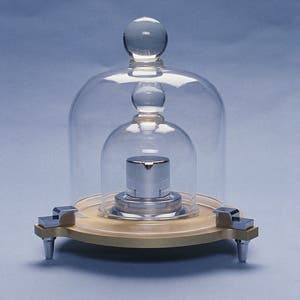It’s quite possibly the most common unit of measure; we often guide our lives based on the humble kilogram, but what is a kilogram really? In other words, how do we know when a kilogram really is exactly a kilogram?
In a few days, one of the most reliable measures of a kilo will be packed up by hand and carried by Canada’s diplomatic corps from Ottawa to France. Special labels will be attached to it, instructing customs and airport security not to open it. Then, the precious cargo will be brought to Paris, where it will meet its “kin” – other mass references. There, at the International Bureau of Weights and Measures (BIPM) just outside the city will test how different weights fare against each other, and whether our definition of a kilo has changed or not.
We currently define 1kg based on a physical object: a cylinder called the International Prototype of the Kilogram (IPK). It is the progenitor of most mass standard bearers and a global reference, but it is still a physical object, which means its mass can change (ever so slightly). This is why regular tests are being carried out from time to time, to see if the IPK has changed mass – because if this is the case, then the relative mass of everything else changes.
Changing the kilogram

Researchers want to bypass this physical limitation by fixing the kilogram to the Planck constant, a fundamental physical constant. This would, in theory, bypass some of the problems, but in order for it to work, we have to be sure that the references used by all labs are similar.
“The question is, How would these independently realized kilograms agree?” says BIPM’s Michael Stock, who is leading the pilot study. Stock expects roughly half a dozen groups to weigh in. Two will hail from the national metrology institutes of Germany and Japan, which maintain ultrapure silicon spheres whose characteristics were recently measured with great precision—one possible way of determining the kilogram. The remaining groups will represent institutes that are working on watt balances, which measure masses against the electrical force needed to resist their weight.
This is, of course, a very delicate problem, and the future of the kilogram remains uncertain in 2018. BIPM hopes to receive all the test masses by the end of March, although the full list of participants for the weighing in Paris hasn’t even been completed. If anything, this will be a test to see if an even wider standardization could work.
“If everything goes well, [the comparisons] would confirm that the future system would work. If it’s not satisfactory, it could be an obstacle [to the redefinition],” Stock says. “So it’s definitely going to be interesting.”






